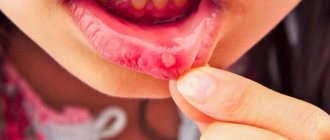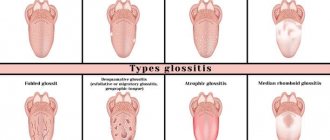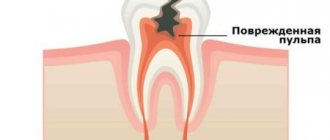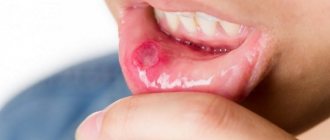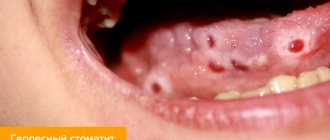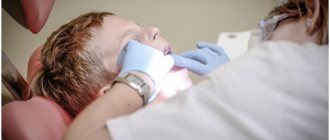Have questions?
Herpetic or herpes stomatitis is an inflammation of the oral mucosa caused by the herpes simplex virus. The disease manifests itself as ulcers in the mouth, headache and even fever.
This type of stomatitis accounts for about 80% of all infectious lesions of the oral cavity. The infection mainly develops in children's bodies, and children under three years of age are most susceptible to it. HIV carriers, diabetics, patients with chronic pathologies and people with weakened immune systems are also at risk.
Clinical manifestations
Symptoms of herpetic stomatitis vary depending on the form and stage of progression of the disease. Common signs of a viral infection include:
- swelling of the cervical and submandibular lymph nodes;
- jump in body temperature;
- blisters on the mucous membrane of the cheeks, tongue, palate, which are damaged and turn into bleeding ulcers and erosive formations;
- discomfort, pain, burning, itching in the mouth;
- weakness, migraine.
In adults, viral herpetic stomatitis is more complicated. At the same time, a severe form of the disease often develops in people who had an acute stage of the disease in childhood, and at the moment their body is weakened due to severe hypothermia, blood disease, cancer, etc.
Acute and chronic herpetic stomatitis
What is stomatitis? What types of stomatitis are more common?
Stomatitis is the general name for diseases that cause inflammation of the oral mucosa.
Among stomatitis, the most commonly diagnosed varieties are those that have a viral basis. Herpetic stomatitis, which is caused by the herpes simplex virus, is especially common.
Clinically, in the oral cavity, herpes infection manifests itself in two forms: 1) chronic recurrent herpes; 2) acute herpetic gingivostomatitis.
Acute herpetic stomatitis is a disease of viral etiology that occurs in both adults and children. Recently, acute herpetic stomatitis is considered as a manifestation of primary herpetic infection with the herpes simplex virus in the oral cavity. The first elements of damage in acute herpetic stomatitis resemble aphthae, which occur against the background of edematous, hyperemic, inflamed oral mucosa. The disease is contagious for individuals who have not previously been infected with the herpes simplex virus. Stomatitis mainly affects children aged 1 to 3 years and young adults.
The disease begins with complaints of general malaise, with an increase in body temperature to 37-37.5 ° C, enlargement of regional lymph nodes, and hypersalivation is observed. The mucous membrane of the mouth, especially the gingival margin, is swollen and hyperemic. At the same time, vesicles filled with serous fluid appear, which then quickly open and merge into erosions, covered with fibrinous plaque, with a scalloped edge along the periphery. The entire process of aft formation lasts four to five days. In this case, the patient complains of pain when eating, burning, itching. If oral care is insufficient, then catarrhal changes (swelling, hyperemia) can turn into ulcerative ones. With proper care and treatment, the patient recovers by the eighth to tenth day. If the disease progresses, the number of erosive elements does not decrease, but increases, the patient’s general condition worsens, weakness, headache, adynamia are observed, body temperature rises to 39–40 ° C, then this may be due to low reactivity of the body, decreased immunity. The body's reactivity depends on various reasons - hypothermia, flu, infectious diseases, blood diseases, cancer. If the necessary treatment of acute herpetic stomatitis is not carried out, a recurrent form occurs, which is accompanied by regular rashes on the mucous membrane of the cavity of vesicles and aphthae.
In the pathogenesis of the disease there are four periods: prodromal, catarrhal, period of rash, period of extinction of the disease. According to the degree of severity, there are mild, moderate, and severe forms.
With a mild form of the disease, there are no symptoms of intoxication of the body. The lesions appear in the form of two or three small bubbles. Epithelization of the mucous membrane occurs quickly.
The moderate form is accompanied by severe toxicosis. Multiple rashes appear on the oral mucosa.
In the severe form, all the signs of an infectious disease are expressed.
A blood test reveals leukopenia, an increase in band neutrophils; saliva reaction is acidic.
Diagnosis of herpetic stomatitis is a difficult task and is based on the use of special molecular biological, virological, serological, cytological and immunological studies.
Treatment of stomatitis can be difficult due to concomitant infection. It includes the prescription of painkillers (gels with lidocaine, articaine topically on the oral mucosa, orally - ketorolac (ketorol, ketalgin)), antiviral drugs (acyclovir or Zovirax orally and topically as an ointment), anti-inflammatory drugs (cholisal, metrogil gel ) and immunomodulators.
Chronic recurrent herpes manifests itself in the form of single or multiple closely spaced rashes - small blisters on the red border of the lips, mucous membrane of the palate, eyes, genitals, skin of the lips, wings of the nose. Usually the appearance of these lesions is accompanied by a burning sensation. Further, the elements merge and form erosive surfaces, and when eating food, painful sensations from irritants occur. A feature of herpes infection is lifelong carriage of the virus after illness.
E. A. Makovskaya, Candidate of Medical Sciences, Geomed Medical Center, Moscow
Note!
- Herpetic stomatitis, which is caused by the herpes simplex virus, is especially common.
- Acute herpetic stomatitis is a disease of viral etiology that occurs in both adults and children.
- Stomatitis mainly affects children aged 1 to 3 years and young adults.
- In the pathogenesis of the disease there are 4 periods: prodromal, catarrhal, period of rash, period of extinction of the disease. According to the degree of severity, there are mild, moderate, and severe forms.
- Diagnosis of herpetic stomatitis is based on the use of special molecular biological, virological, serological, cytological and immunological studies.
- With proper care and treatment, the patient recovers by 8-10 days.
Classification of the disease
Before starting treatment for herpes stomatitis, it is necessary to determine the form and degree of its progression. At the same time, acute herpetic stomatitis in children is diagnosed already when the virus first enters the body.
The severity of the disease is divided into:
- Light. Small blisters form on the oral mucosa - they quickly disappear after they rupture;
- Average. The rashes are more extensive, body temperature rises (up to 38º);
- Heavy. The patient has an abundance of ulcers in his mouth, and after they disappear, new ones appear. Symptoms are supplemented by fever, headache and chills, sometimes the patient feels sick and has diarrhea.
In the absence of proper treatment, chronic recurrent herpetic stomatitis develops. This form of the disease is already characterized by group rashes (on the inside of the cheeks, tongue and palate). The formations combine and form painful erosions. In the recurrent stage, except for rashes, no other symptoms of the disease are noted. The disease may return 2-6 months after treatment.
Treatment of herpetic stomatitis at the “Family Dentist”
Therapy for OHS is complex; in mild to moderate cases, it is carried out at home. The dentist prescribes medications, gives recommendations on nutrition and oral hygiene. The cost of an appointment in our clinic is from 10 rubles.
When herpetic stomatitis is diagnosed in children, the treatment regimen includes:
- Diet. Food should be liquid or semi-liquid (mashed soups, vegetable purees, cereals, jelly, yoghurts, minced meat and fish) at a comfortable temperature. In case of extensive erosions, it is advisable to feed the baby liquid food through a tube.
- Prevention of dehydration. Water balance is maintained with dried fruit compotes, broths, plain water, and a weak rosehip decoction.
- Oral hygiene. To prevent the development of a secondary infection, teeth should be cleaned with a soft brush without paste, and the mucous membrane should be treated with a swab and a warm antiseptic solution. You should rinse your mouth every time after eating.
- Local, general therapy. The drugs are prescribed by the dentist, taking into account the severity of the acute syndrome.
Mild degree. Ulcerations of the mucous membrane are treated 3-4 times a day with a cotton pad or bandage soaked in a solution of chlorhexidine 0.05% or miramistin. If necessary, the doctor prescribes an antiviral ointment. If there is no risk of seizures, antipyretic drugs are not prescribed.
Moderate degree. At the height of herpetic stomatitis, treatment with local antiseptic solutions is supplemented with tableted antiherpetic drugs, if the rash does not begin to dry out on the 2nd–3rd day. Medicines have an effect on the entire body, therefore they are taken only as prescribed by a doctor. The mucous membrane after a viral infection is restored with healing agents with vitamins A, E, and sea buckthorn oil. To reduce pain, lidocaine gel is applied to the mucous membrane 20 minutes before meals.
Severe degree. The dentist refers you to the hospital, treatment is carried out with injectable drugs, immunostimulants, and physiotherapy is prescribed.
To make an appointment at the “Family Dentist” in Minsk, fill out the form or call. You don't have to stand in line with a sick child.
How to treat herpetic stomatitis?
Treatment of herpetic stomatitis in children and adults can be general or local. The therapeutic treatment strategy is determined by the form and severity of the disease. In this case, the patient is usually shown:
- high-calorie diet, drinking plenty of fluids, bed rest;
- antiviral drugs (orally, intravenously or intramuscularly);
- restorative therapy (taking vitamins);
- symptomatic treatment (use of antipyretics, painkillers, anti-inflammatory drugs);
- local therapy (rinses, applications, etc.).
When choosing tactics for treating acute or chronic herpetic stomatitis in adults and children, it is important to correctly determine the form and stage of the disease. That is why experts urge patients not to self-medicate, but to immediately consult a doctor if signs of damage appear.
Therapy under the supervision of a specialist will allow you to recover quickly and without consequences for the body. With the right approach, herpes stomatitis in a child or adult can be cured in 10-14 days.
Herpetic stomatitis: symptoms
Taking into account the nature of the disease and the characteristics of its course in the patient, two forms are distinguished: acute and chronic recurrent. In the first form, the symptoms are very pronounced, the disease is more severe, and all signs usually disappear completely after adequate treatment. In the chronic relapsing form, the symptoms are less pronounced, long periods of remission (“rest”) are observed with periodic relapses.
Acute herpetic stomatitis most often occurs in young children and adolescents. In adults, this disease occurs much less frequently, since their immune system works better and more actively than children's. This disease is also called herpetic aphthous stomatitis, due to specific aphthous ulcers in the patient’s mouth. The main signs of stomatitis in children and adults are:
- Swelling and redness of the mucous membranes of the mouth.
- Single or grouped vesicles with serous contents in small areas of the mucous membrane. When such bubbles collapse, erosive spots with a whitish coating in the center are formed. Such erosions are very similar to true aphthae, so the disease was previously classified as herpetic aphthous stomatitis, although in fact we are talking about two different types of the same disease.
- Pain when eating and drinking, burning and itching in the mouth.
- Weakness, fever, nausea, possibly vomiting and diarrhea. These symptoms almost do not appear with mild degrees of the disease; with moderate and severe degrees they are quite pronounced.
What the oral cavity looks like with herpetic stomatitis can be seen in the photo.
How to treat catarrhal and ulcerative stomatitis?
Both types of disease are direct consequences of poor oral hygiene or incorrectly selected toothpaste. Most often they are localized deep on the inner surface of the cheeks and closer to the root of the tongue - where the toothbrush cannot reach when brushing quickly. There may be no painful symptoms, but the mucous membrane swells and dries out due to lack of saliva.
Treatment is long, because the main task is to normalize daily hygiene, and only then begin active therapy:
- Rinsing with a solution of furatsilin, rivanol, etc. after every meal.
- Treatment of the affected surface with chlorhexidine.
- A month's course of antibiotics and antifungals.
If stomatitis develops into an ulcerative form, then a local anesthetic gel will not be enough; pentalgin or another analgesic for oral administration is prescribed.
